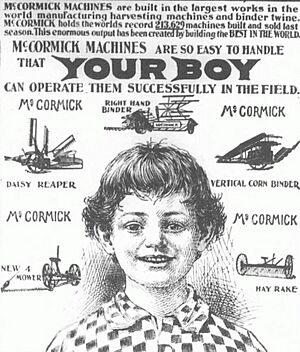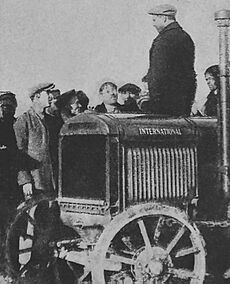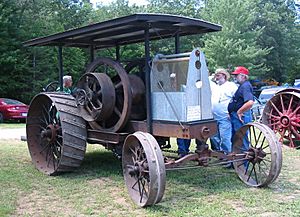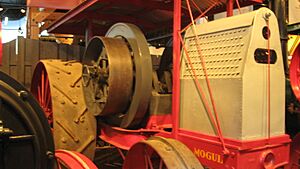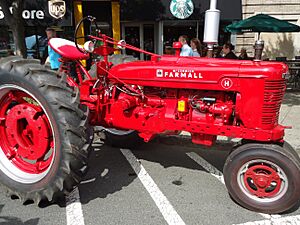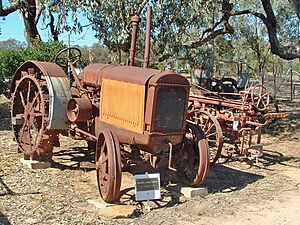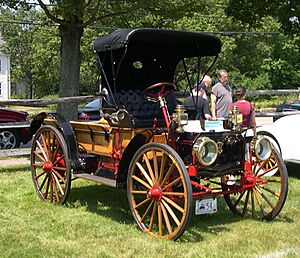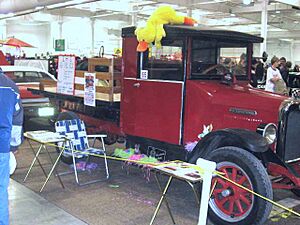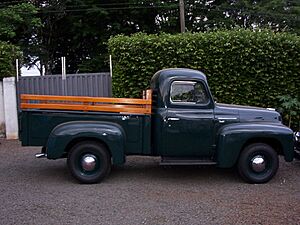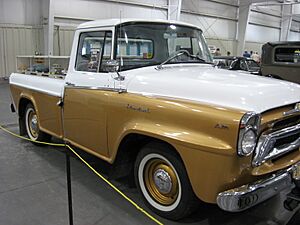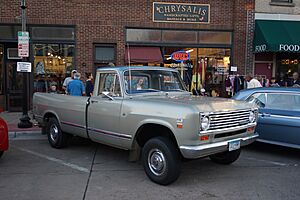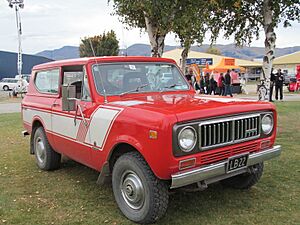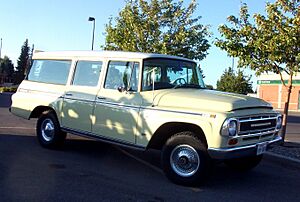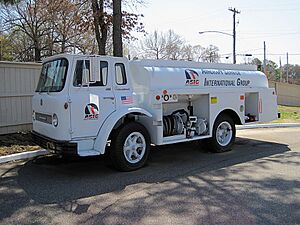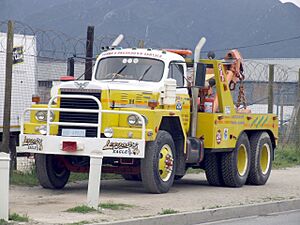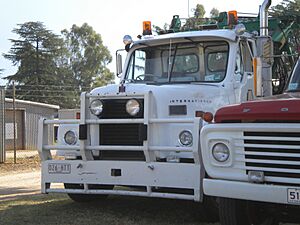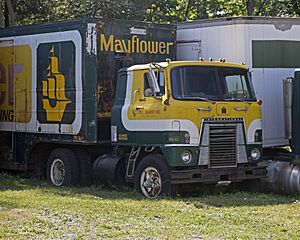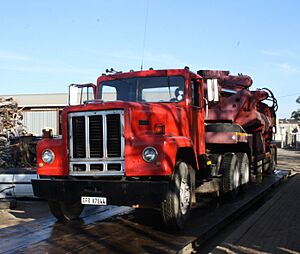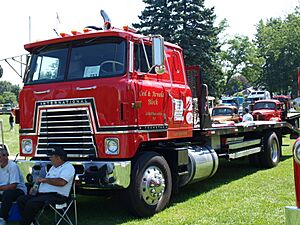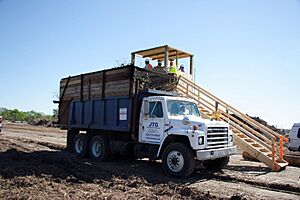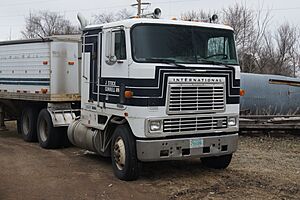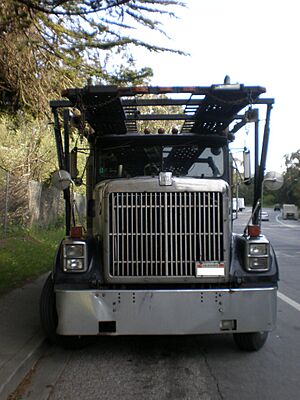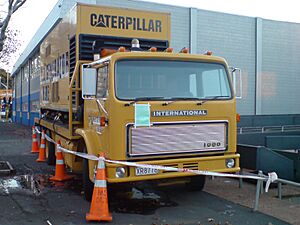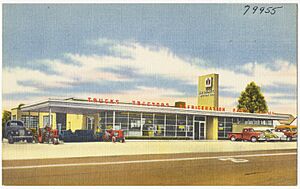International Harvester facts for kids
 |
|
| Industry | Agricultural Automotive |
|---|---|
| Fate | Renamed as Navistar International Corporation |
| Predecessor |
|
| Successor |
|
| Founded | March 22, 1902 |
| Founders |
|
| Defunct | 1985 |
| Headquarters | Chicago, Illinois, U.S. |
|
Area served
|
Worldwide |
| Products | |
The International Harvester Company (often called IH or International) was a big American company. It made many things, like farm equipment, construction machines, trucks, and even household items. IH was created in 1902 when the McCormick Harvesting Machine Company and Deering Harvester Company joined together. Three smaller companies also merged with them.
Some of their famous brands included McCormick, Deering, and later McCormick-Deering. They also made popular tractors like the Farmall and Cub Cadet. IH was also known for its vehicles, like the Scout and Travelall.
Even today, many people love the International Harvester brand. They even have groups that host large farming events in the United States.
In the 1980s, the company faced tough times. International Harvester started selling off its different parts. First, they sold the construction division to Dresser Industries in 1982. Then, in 1984, they sold the farm equipment part to Tenneco. This part became Case IH, which is now owned by CNH Industrial. The European part of the company became McCormick Tractors, owned by ARGO SpA of Italy.
After these sales, International Harvester focused only on making trucks and engines. In 1986, the company changed its name to Navistar International. International Harvester was always based in Chicago, Illinois. In 2020, Volkswagen bought the remaining shares of Navistar.
Contents
History of International Harvester
How International Harvester Started
The story of International Harvester goes back to the 1830s. That's when Cyrus Hall McCormick, an inventor from Virginia, perfected his horse-drawn reaper. This machine helped farmers harvest crops much faster. He showed it off in 1831 and got a patent for it in 1834.
In 1847, Cyrus and his brother Leander J. McCormick moved to Chicago. They wanted to be closer to the big grain fields in the Midwest. There, they started the McCormick Harvesting Machine Company. Their reaper sold very well. This was partly because they used smart business ideas. They also benefited from the new railroads, which helped them send their products far away.
After Cyrus McCormick died in 1884, his son, Cyrus McCormick, Jr., took over. In 1902, the McCormick Harvesting Machine Company joined with the Deering Harvester Company. Three other smaller farm equipment companies also merged with them. This created the International Harvester Company. The main reason for this big merger was to reduce competition and make more money. A banker named J. P. Morgan helped with the financing. The new company was worth $150 million.

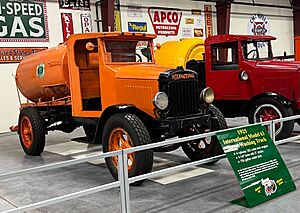
Years of Success
In 1926, IH built a new factory in Rock Island, Illinois, for its Farmall tractors. By 1930, they had made 100,000 Farmall tractors. IH then wanted to make a "general-purpose" tractor for the average American family farmer. The "letter" series of Farmall tractors, designed by Raymond Loewy in 1939, was a huge hit. IH was a leader in the tractor market through the 1950s. They faced strong competition from companies like Ford and John Deere.
During World War II, IH helped the war effort. Their factories made torpedoes, artillery parts, and other military items. In 1946, IH bought a defense plant in Louisville, Kentucky. They changed it to make Farmall tractors. In 1974, IH made its five-millionth tractor, a 1066 model.
Even though sales were good in the 1960s and 1970s, IH didn't make a lot of profit. The company had too many different types of products. Also, their management was very traditional, which made it hard to try new ideas. IH also faced more competition and higher costs.
The Company's Decline
In 1977, IH got a new CEO, Archie McCardell. He wanted to cut costs and make more profit. Some product lines that weren't making money were stopped. By the end of the year, profits were good, but the company still didn't have much cash. Workers were upset about these changes.
On November 2, 1979, a big strike began. It lasted a long time and cost the company almost $600 million. By 1981, IH was in a very bad financial state. Investors had lost trust in the company.
In 1982, Louis W. Menk became the new chairman and CEO. He led a big reorganization of the company. IH had to make big cutbacks. They sold their construction equipment division to Dresser Industries. More parts of the company were sold to Tenneco, Inc., in 1984.
After these sales, tractor production at the Farmall Works stopped in 1985. The company's name changed to Navistar International Corporation in 1986. Navistar still makes medium and heavy-duty trucks and engines today.
Products and Divisions
Agriculture Division
The International Harvester Agriculture Division was very well-known. It made many kinds of farm equipment. One of its first products was the Traction Engine.
From 1902 to the early 1920s, McCormick and Deering dealerships kept their own brands. McCormick sold Mogul tractors, and Deering sold Titan tractors. This was because the two companies were still quite competitive.
Early Tractors
IH made large gasoline-powered farm tractors under the Mogul and Titan brands. These early tractors had mixed success. But by the mid-1910s, farmers wanted smaller and cheaper tractors.
The company's first important tractors were the 10-20 and 15-30 models, introduced in 1915. They were used to pull plows and power threshing machines. IH also bought several smaller companies that made plows and other farm tools.
In 1924, IH introduced the Farmall. This was a smaller, general-purpose tractor. It helped IH compete with Ford's Fordson tractors. The Farmall became a leader in the "row-crop tractor" market.

In 1932, IH made its first diesel engine for the McCormick-Deering TD-40 crawler tractor. This engine started on gasoline and then switched to diesel. This made it easier to start in cold weather. In 1935, it was used in the WD-40, which was the first diesel tractor on wheels in North America.
The "Letter" and "Standard" Series
In 1939, Raymond Loewy designed the look for the Farmall "letter series" tractors (like the A, B, H, and M). He also designed the McCormick-Deering "standard series." Many of these tractors are still used on farms today.
In 1947, the smallest tractor in the Farmall line, the Cub, was introduced. It was designed for small farms that still used horses. The Cub was very popular, and its design stayed mostly the same until 1979.
In 1955, IH introduced the "hundred series" of tractors. These were updated versions of the 1939 models.
Tractors in the 1960s and 1970s
Throughout the 1960s, IH brought out new tractors. In 1963, they introduced the 706 and 806 tractors. In 1964, IH made its four-millionth tractor, an 806. In 1965, IH introduced its first 100-horsepower, two-wheel-drive tractor, the 1206.
In 1967, IH introduced the more powerful 56 series tractors. These included the 656, 756, 856, and 1256. In 1969, the 1456 Turbo was introduced.
In 1971, IH introduced the 66 series line of tractors. These new models included the 766, 966, 1066 turbo, and 1466 Turbo. On February 1, 1974, IH made its five-millionth tractor. IH was the first tractor maker to reach this milestone. Also in 1973, IH stopped using the "Farmall" name for its tractors.
In 1976, IH changed the paint and decals on its tractors. They were now all red with a black stripe. In September 1976, IH released their 86 series Pro Ag Line. These new tractors had a new cab called the Control Center. It came with air conditioning and heat.
In 1977, International Harvester introduced the first Axial-Flow rotary combine. This machine was the first of many Axial-Flow combines made over 30 years.
Tractors in the 1980s
In September 1981, IH announced the new "50 Series" of tractors. These included the 5088, 5288, and 5488. IH also released the "30 series" tractors. These new tractors showed that IH was still very innovative. They were designed by Gregg Montgomery and had a new, stylish look.
The new series had many technology improvements. They had a computer monitoring system and an 18-speed transmission. The 50 Series also came with a three-year or 2,500-hour warranty, which later became standard in the industry. On May 14, 1985, the last IH tractor, a 5488 FWA, rolled off the factory line.
Agricultural Brand Names
Over the years, IH used different brand names for its tractors and harvesting products:
- International (1902–1985)
- Titan (1910–1924)
- Mogul (1911–1924)
- McCormick–Deering (1922–1947)
- McCormick (1947–1958)
- Farmall (1924–1973)
- Fairway (1924–1938)
- Electrall (1954–1956)
- Cub (1947–1985)
Other Farm Products
Besides tractors, IH also sold many other types of farm equipment. This included balers, cultivators, combines, corn shellers, cotton pickers, manure spreaders, hay rakes, and plows. They also made twine, stationary engines, and wagons.
Earthmoving Division
IH also made equipment for moving earth, like for construction. They bought other companies to get new technology. For example, they bought the Frank G Hough company, which made a machine called a PayLoader. They also bought the French company Yumbo, which made hydraulic excavators.
Between 1956 and 1982, IH made and sold off-road dump trucks called 'PayHaulers'. In 1974, IH renamed this division the 'Payline' division.
Payloaders
The first PayLoader was a tractor with forks welded to the front. Frank Hough invented this idea. His company worked closely with IH until IH bought it in 1952. PayLoaders became a general term for any front loader machine. They came in different types, like wheeled and track loaders.
PayScrapers
In the early 1950s, construction companies started using motor scrapers to move dirt. IH didn't have a motor scraper. So, in 1953, IH bought Heil's road machinery division. This gave them a range of motor and towed scrapers.
Electrall System
The Electrall system was introduced in 1954. It was a way to power farm equipment using electricity. It had a generator that could even power a house. A 10 kW Electrall generator was an option on the Farmall 400 tractor. IH showed how it could power a haybaler.
Road Vehicles
Light Duty Trucks
IH was known for making successful and innovative "light" vehicles, like pickup trucks. They made light trucks from 1907 to 1975. Their first was the Model A Auto Wagon (also called the "Auto Buggy"). It was popular in rural areas because it had high ground clearance for bad roads. It had a back seat that could turn into a cargo bed. The Auto Wagon was renamed the Motor Truck in 1910. These trucks were called IHC until 1914, when the 'International' name was first used. The last light truck was made on May 5, 1975.
IH also made the Metro line of delivery vans. These were made from 1938 through 1975.
IH stopped selling passenger vehicles in 1980 to focus on commercial trucks and school buses.
Sport-Utility Vehicles
One of IH's light-duty vehicles was the Travelall. It was similar to the Chevrolet Suburban. The Travelette was a crew cab truck with four doors. The 1961 Travelette was the first six-passenger, four-door truck of its time.
The Scout, first made in 1961, was a small, two-door SUV, like a Jeep. In 1972, it became the Scout II. After IH stopped making pickups and Travelalls in 1975, the Scout Traveler and Terra became available. These had a longer wheelbase than the standard Scout II.
Motorhomes
In the 1970s, some motorhomes were built using IHC engines and chassis. Most of their bodies were made of fiberglass.
Commercial Trucks (Truck and Engine Division)
International Harvester was an early maker of medium and heavy-duty trucks. They also made the chassis for school buses. In 1962, IH offered the International Harvester Loadstar, which became a top medium-duty truck. In 1978, IH offered the International Harvester S-Series, which replaced the Loadstar in 1979.
After the agricultural division was sold in 1985, International Harvester Company changed its name to Navistar International in 1986. Today, Navistar International's company, International Truck and Engine Corporation, still makes trucks and engines under the International brand.
International Harvester Around the World
Australia
International Harvester Australia, a part of the US company, worked closely with the Australian Army. They designed and built trucks for the army. These trucks were used in places like the Vietnam War.
ACCO Trucks
The Australian-designed and built International Australian C-line Cab Over (ACCO) truck was first made in 1972. It's a "cab over engine" type truck, meaning the driver sits above the engine. ACCO trucks were built to order for different customers. They were used by private companies, fire departments, the military, and city departments across Australia and New Zealand. The ACCO became the most popular product of International Harvester in Australia. It was stopped in November 2019 and replaced by a new European-designed ACCO.
Brazilian Subsidiary
International Harvester Máquinas S.A. was started in Brazil with government help. Their first product was the International S-184 heavy truck. In 1966, Chrysler bought International's plant in Brazil.
Home Products
Home Appliances
Even though IH was best known for farm equipment, they also made home appliances. This included refrigerators, air conditioners, and freezers. IH had its own refrigeration division. They first made commercial items for farmers who were just getting electricity. These included milk coolers and walk-in freezers. Later, IH made kitchen refrigerators for homes. The IH spokeswoman for these products was Irma Harding. These products were introduced in 1947 and sold for less than 10 years. The refrigeration division was sold to Whirlpool Corporation in 1955. Because they were made for a short time, IH appliances are rare today.
Lawn and Garden Equipment
In 1961, IH started making lawn and garden equipment with its Cub Cadet line. This included riding and walk-behind lawn mowers and snow blowers. They also made compost shredders and rotary tillers. The Cub Cadet line was sold to MTD Products in 1981.
Other Products
Defense Products
IH made light, medium, and heavy vehicles for military use. For example, they sold a Metro van to the Czechoslovakian Army in 1938. They also made trucks for the US Navy and Marines in 1942.
Weapons
From 1953 to 1956, International Harvester made M1 rifles for the United States Army. They produced over 337,000 rifles.
HT-341 Jet Tractor
In 1959, International Harvester created a special tractor called the International HT-341. It was powered by a jet turbine engine! This unique tractor was later given to the Smithsonian Institution in 1967.
Images for kids
-
International 660 in rural Saskatchewan
-
1939 advertisement for the International "Jungle Yacht" tractor-trailer, for Attilio Gatti's luxury scientific expedition in the Belgian Congo
See also
- Farmall tractor
- Farmall Cub
- High wheeler
- International Harvester Scout
- "International Harvester" song
- List of International Harvester/Navistar engines
- List of International Harvester vehicles
- Lee Klancher



